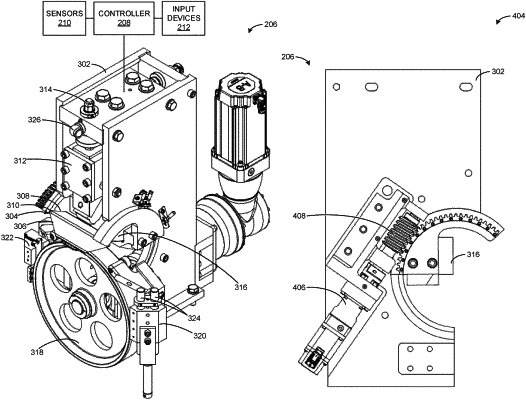| CPC B21D 5/083 (2013.01) [B21D 5/14 (2013.01)] | 23 Claims |

|
1. A machine to form a cross-section in a stationary component, the machine comprising:
a first roll to engage the stationary component;
a second roll to set a forming angle for movement along the stationary component, the stationary component formed between the first roll and the second roll;
a first cam follower upstream relative to the first roll and the second roll;
a second cam follower downstream relative to the first roll and the second roll,
the first cam follower and the second cam follower to maintain a vertical position of a peripheral edge of the stationary component,
the second cam follower including a brush to contact the stationary component, the brush to remove galvanization from the stationary component, and
the first roll, the second roll, the first cam follower, and the second cam follower configured to move together along the stationary component;
an arc-shaped gear including teeth on an outer surface of the arc-shaped gear, an inner surface of the arc-shaped gear defining a cutout in the arc-shaped gear, the second roll coupled to the inner surface at the cutout; and
a worm gear operatively coupled to the teeth of the arc-shaped gear, rotation of the worm gear to cause rotation of the arc-shaped gear, the second roll to rotate with the arc-shaped gear about a fixed point to adjust the forming angle.
|
|
19. A machine to form a cross-section in a component, the machine comprising:
a first roll to engage a first surface of the component;
a second roll to engage a second surface of the component opposite the first surface;
a third roll to apply a force to the component to form the cross-section, a first angle of the third roll relative to the component being adjustable during movement of the component along the third roll; and
a first cam follower upstream relative to the first, second, and third rolls;
a second cam follower downstream relative to the first, second, and third rolls,
the first cam follower and the second cam follower to maintain a vertical position of a peripheral edge of the component,
the first, second, and third rolls and the first and second cam followers configured to move together along the component;
an arc-shaped gear including teeth on an outer surface of the arc-shaped gear, the third roll coupled to an inner surface of the arc-shaped gear; and
a worm gear operatively coupled to the teeth of the arc-shaped gear, rotation of the worm gear to cause rotation of the arc-shaped gear, the third roll to rotate with the arc-shaped gear about a fixed point to adjust the first angle.
|
|
23. A machine to form a cross-section in a component, the machine comprising:
a first roll to engage the component;
a second roll to set a forming angle for the component during movement of the component relative to the first and second rolls, the component formed between the first roll and the second roll;
a first cam follower upstream relative to the first roll and the second roll;
a second cam follower downstream relative to the first roll and the second roll, the first cam follower and the second cam follower to maintain a vertical position of a peripheral edge of the component, the second cam follower including a brush to contact the component, the brush to remove galvanization from the component;
an arc-shaped gear having a convex first surface and a concave second surface, the second roll coupled to the concave second surface of the arc-shaped gear;
a plurality of teeth coupled to the convex first surface of the arc-shaped gear; and
a worm gear operatively coupled to the teeth of the arc-shaped gear, rotation of the worm gear to cause rotation of the arc-shaped gear, the second roll to rotate with the arc-shaped gear about a fixed point to adjust the forming angle.
|